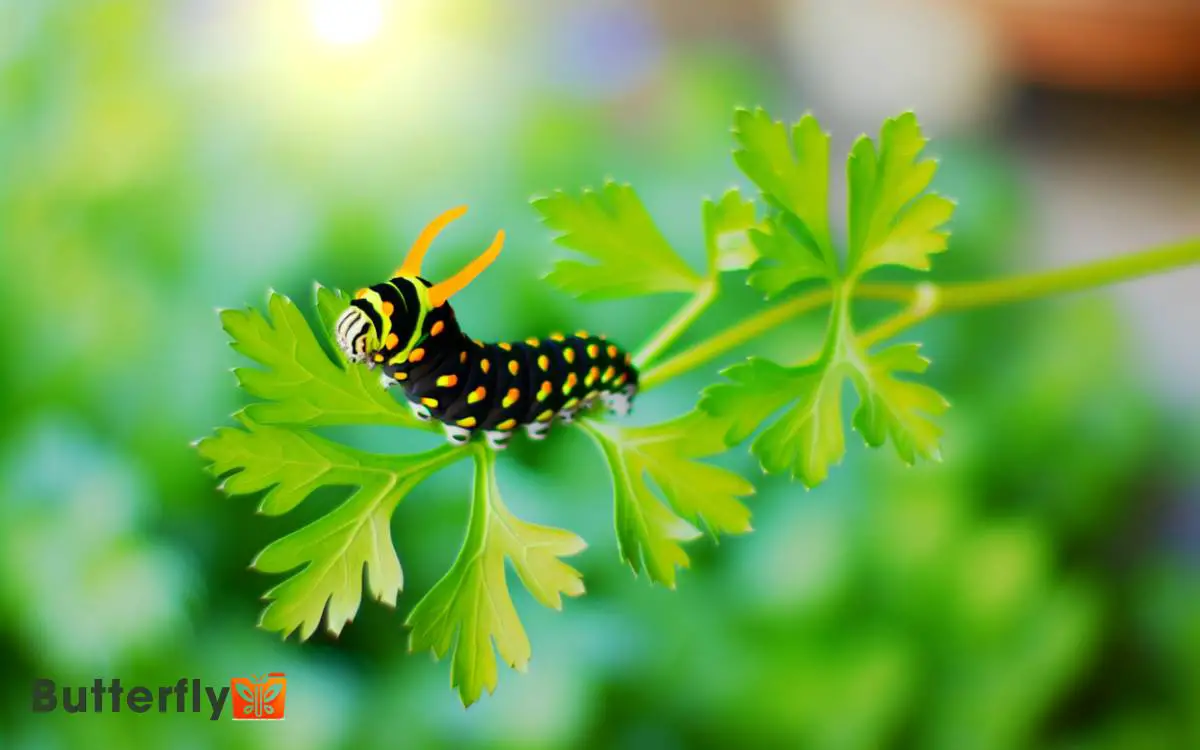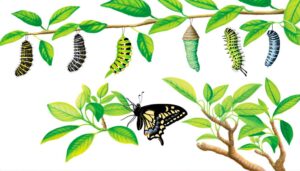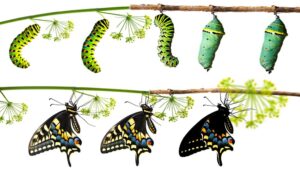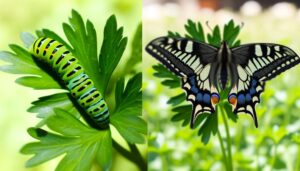Black Swallowtail Butterfly Caterpillar Orange Horns: Explore!
The Black Swallowtail butterfly caterpillar‘s orange horns, known as osmeteria, are a unique defense mechanism. When threatened, the caterpillar everts these bright orange, forked structures, releasing volatile compounds that deter predators.
This display is accompanied by aposematic coloration, featuring vibrant green and black bands. The osmeteria’s rapid eversion and retraction are powered by specialized muscles, ensuring effective dispersal of these deterrent compounds.
This combination of chemical and visual defenses highlights the caterpillar’s evolutionary adaptations for survival.
To understand how these mechanisms function and their broader ecological impact, further exploration is essential.

Key Takeaways
Caterpillar Identification
The Black Swallowtail butterfly caterpillar, identifiable by its distinctive coloration and pattern, exhibits a striking combination of green, black, and yellow stripes.
Each segment of its body showcases transverse bands of black adorned with yellow spots, creating a visually disruptive pattern that likely serves as a deterrent to predators.
The caterpillar possesses a series of prolegs and true legs, facilitating its mobility across host plants. Importantly, it exhibits osmeteria, an eversible gland located behind the head, which releases a pungent odor when threatened.
This defensive mechanism, coupled with its aposematic coloration, underscores its evolved strategies for survival.
The presence of these morphological and behavioral traits ensures the caterpillar’s identification is unmistakable for both researchers and enthusiasts alike.
Habitat and Range
Black Swallowtail butterfly caterpillars primarily inhabit temperate regions across North America, thriving in diverse environments such as gardens, meadows, and fields where host plants like parsley, dill, and fennel are abundant. These caterpillars are known for their striking green and black banded appearance, which helps them blend into their surroundings. The eastern black swallowtail caterpillar undergoes several molts as it grows, eventually developing distinctive orange osmeteria that it uses as a defense mechanism against predators. As they mature, they prepare to form chrysalises, marking the final stage before transforming into beautiful Black Swallowtail butterflies.
They exhibit a wide ecological amplitude, adapting to both cultivated and wild habitats. Their geographical range extends from southern Canada through the United States to northern Mexico.
These caterpillars are often found at altitudes ranging from sea level to moderate elevations.
The presence of umbelliferous host plants is critical for their survival, as these plants serve as both food sources and oviposition sites.
Observations indicate that habitat fragmentation and pesticide use can have a significant impact on their populations, emphasizing the need for conservation measures in agricultural and urban settings.
Life Cycle Stages
A typical life cycle of the Black Swallowtail butterfly encompasses four distinct stages: egg, larva (caterpillar), pupa (chrysalis), and adult butterfly.
The cycle begins when the female deposits eggs on host plants like parsley or dill. After hatching, larvae progress through five instars, each marked by molting.
During these stages, larvae exhibit rapid growth and develop orange osmeterium, a defense mechanism. Upon reaching full size, the caterpillar forms a chrysalis, undergoing metamorphosis.
Inside the pupal casing, cellular reorganization transforms the larva into an adult butterfly. This emergence marks the final stage, where the butterfly seeks mates to perpetuate the cycle.
Understanding each phase reveals the intricate processes governing this species’ remarkable life journey.
Physical Characteristics
Sporting vibrant green and black bands, the Black Swallowtail butterfly caterpillar also features distinctive orange osmeterium for defense.
These caterpillars exhibit a striking interplay of colors and patterns that serve as both camouflage and warning signals.
Their bodies are segmented, each segment bearing specific markings and tiny setae that enhance tactile sensitivity. The head capsule is small, with well-developed mandibles adapted for herbivorous consumption.
| Feature | Description | Function |
|---|---|---|
| Bands | Vibrant green and black | Camouflage, warning |
| Osmeterium | Bright orange, forked structure | Defense, chemical deterrent |
| Segments | Clearly defined, patterned | Flexibility, movement |
| Setae | Tiny hair-like structures | Sensory perception |
| Mandibles | Strong, well-developed | Herbivorous feeding |
These detailed physical characteristics not only highlight their adaptability but also their intricate evolutionary design.
The Osmeteria
The osmeteria, an eversible gland located behind the caterpillar’s head, releases volatile compounds as a chemical defense mechanism against potential predators. When threatened, the Black Swallowtail caterpillar everts these bright orange, forked structures.
The osmeterium’s deployment is swift, triggered by tactile or chemical stimuli. The gland’s anatomy includes specialized muscles that facilitate rapid eversion and retraction.
Composed of soft, flexible tissue, the osmeterium’s surface area maximizes exposure to air, enhancing the dispersion of its compounds.
Morphologically, this gland is a distinctive adaptation, absent in many other lepidopteran larvae. Observations reveal that osmeterial response varies, dependent on the intensity and nature of the threat.
This organ exemplifies the intricate evolutionary strategies employed by caterpillars to secure their survival.
Chemical Defense Mechanism
Black Swallowtail caterpillars employ their osmeteria to release a suite of volatile compounds, effectively deterring predators through a sophisticated chemical defense mechanism.
Upon disturbance, the caterpillar everts these glandular structures, emitting terpenes and isobutyric acid. These chemicals produce a strong, unpleasant odor, serving as a potent irritant to potential threats.
The osmeterium’s efficacy lies in its ability to rapidly deploy these compounds, creating an immediate chemical barrier. This mechanism not only provides a direct deterrent but also integrates with the caterpillar’s overall survival strategy.
Predator Deterrence
Employing an array of chemical and behavioral strategies, the Black Swallowtail caterpillar effectively deters potential predators, ensuring its survival in a hostile environment.
Upon sensing danger, it deploys its distinctive orange osmeterium, a glandular organ resembling horns, which releases volatile, foul-smelling compounds.
This sudden display, coupled with the emission of butyric acid and terpenes, creates an immediate sensory assault, repelling would-be attackers.
Additionally, the caterpillar exhibits cryptic coloration during its early instar stages, blending seamlessly with its surroundings. This camouflage, combined with the osmeterium’s chemical arsenal, provides a multifaceted approach to predator deterrence.
These adaptive strategies highlight the caterpillar’s evolutionary ingenuity in negotiating threats while maintaining its autonomy and resilience in the wild.
Role in Survival
By utilizing its osmeterium and cryptic coloration, the Black Swallowtail caterpillar maximizes its chances of reaching adulthood despite numerous ecological threats. The osmeterium, a specialized gland, secretes volatile compounds that deter predators.
Coupled with its green and black coloration, the caterpillar achieves effective camouflage against foliage. These adaptations serve to reduce mortality rates during larval stages.
| Adaptation | Function |
|---|---|
| Osmeterium | Secretes deterrent chemicals |
| Cryptic Coloration | Camouflages against predators |
| Diapause | Delays development in unfavorable seasons |
| Host Plant Selection | Chooses plants with fewer predators |
| Rapid Growth | Minimizes vulnerable larval period |
Such physiological adaptations underscore the caterpillar’s evolutionary strategies for survival, enhancing its resilience in fluctuating environments.
Scientific Studies
Researchers have extensively studied the Black Swallowtail caterpillar’s adaptations, focusing on the biochemical properties of its osmeterium and the genetic basis of its cryptic coloration.
These studies reveal that the osmeterium secretes a blend of isobutyric and 2-methylbutyric acids, deterring predators effectively.
Genetic sequencing has identified specific alleles responsible for the caterpillar’s mimicry of bird droppings, enhancing its survival through camouflage.
- Biochemical Analysis: Detailed mass spectrometry of osmeterium secretions confirms the presence of deterrent compounds.
- Genetic Studies: CRISPR-Cas9 techniques have pinpointed genes important for cryptic coloration.
- Behavioral Experiments: Controlled predator-prey interactions validate the efficacy of both chemical and visual defenses.
These findings provide an insightful understanding of the adaptive mechanisms underpinning the caterpillar’s survival strategy.
Observing in Nature
In their natural habitats, Black Swallowtail caterpillars exhibit distinct behavior patterns, including active foraging on host plants such as parsley and dill.
Observers note their interaction with these plants often involves molting phases and the deployment of their osmeterium for defense.
Seasonal appearance trends indicate a higher frequency during late spring and summer, correlating with ideal environmental conditions for growth and development.
Habitat and Behavior Patterns
Observing the Black Swallowtail butterfly caterpillar in its natural habitat reveals a preference for open fields and gardens, specifically those abundant in Apiaceae plants like dill and parsley.
These caterpillars exhibit crepuscular behavior, being most active during dawn and dusk. They’re solitary and display territorial tendencies, often found on host plants where they both feed and camouflage.
Key observations include:
- Locomotion: Slow, deliberate movements on host plants.
- Defense Mechanism: Eversible orange osmeterium that releases a pungent odor to deter predators.
- Growth Stages: Undergo five instars, each marked by specific morphological changes.
Interaction With Plants
The Black Swallowtail caterpillar exhibits a specialized interaction with host plants, utilizing its mandibles to efficiently consume leaves while integrating its body coloration for effective camouflage.
This larval stage primarily targets Apiaceae family members like fennel, dill, and parsley, maximizing nutritional intake. The caterpillar’s cryptic coloration blends seamlessly with the host foliage, minimizing predation risk.
Observations reveal that its osmeterium, a glandular organ, can be everted to release foul-smelling chemicals, deterring predators. The caterpillar’s feeding behavior shows a preference for younger, tender leaves, optimizing growth rates.
Phytophagous activity is methodical, with caterpillars often skeletonizing leaves, leaving behind characteristic feeding marks. This intricate plant interaction underscores the adaptive strategies essential for survival and metamorphosis into the adult butterfly.
Seasonal Appearance Trends
Throughout various seasons, Black Swallowtail caterpillars exhibit bright green coloration that correlates with temperature fluctuations and host plant availability. During spring, larvae often display vibrant green hues, aiding in camouflage among fresh foliage.
As summer progresses, the coloration may shift to darker greens or even black, optimizing thermoregulation and predator avoidance.
These seasonal variations are critical for survival, ensuring the caterpillars remain inconspicuous to predators and efficiently regulate their body temperature.
Additionally, the availability of specific host plants like dill, parsley, and fennel directly impacts larval development stages across seasons.
- Spring: Larvae mainly exhibit bright green coloration.
- Summer: Darker hues emerge, including variations of green and black.
- Autumn: Caterpillars may show mixed coloration, reflecting the senescence of host plants.
Conservation Efforts
Efforts to conserve the Black Swallowtail butterfly caterpillar focus on habitat preservation, pesticide reduction, and public education to mitigate population decline.
Conservationists advocate for the planting of host plants such as dill, fennel, and parsley to support larval development. Reducing chemical pesticide use prevents toxic exposure, essential for larval survival.
Educational outreach programs inform the public about the ecological significance of these caterpillars and their role in pollination.
| Strategy | Description | Goal |
|---|---|---|
| Habitat Preservation | Planting host plants (dill, fennel, parsley) | Support larval development |
| Pesticide Reduction | Limiting chemical pesticide usage | Prevent toxic exposure |
| Public Education | Outreach programs on ecological importance | Raise awareness |
These combined efforts aim to stabilize and increase Black Swallowtail populations.
Conclusion
To sum up, the black swallowtail butterfly caterpillar, with its distinctive orange osmeteria, showcases a fascinating array of survival adaptations. Found across diverse habitats, this species exhibits a complex life cycle and unique physical characteristics.
The osmeteria, likened to nature’s tiny chemical weapon, play a critical role in predator deterrence. Ongoing scientific studies and conservation efforts aim to unravel more secrets of this remarkable insect, ensuring its continued presence in our ecosystems for future generations.






